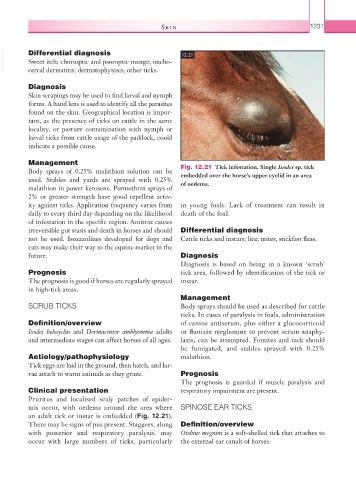Page 1256 - Equine Clinical Medicine, Surgery and Reproduction, 2nd Edition
P. 1256
Skin 1231
VetBooks.ir Differential diagnosis 12.21
Sweet itch; chorioptic and psoroptic mange; oncho-
cercal dermatitis; dermatophytosis; other ticks.
Diagnosis
Skin scrapings may be used to find larval and nymph
forms. A hand lens is used to identify all the parasites
found on the skin. Geographical location is impor-
tant, as the presence of ticks on cattle in the same
locality, or pasture contamination with nymph or
larval ticks from cattle usage of the paddock, could
indicate a possible cause.
Management
Body sprays of 0.25% malathion solution can be Fig. 12.21 Tick infestation. Single Ixodes sp. tick
used. Stables and yards are sprayed with 0.25% embedded over the horse’s upper eyelid in an area
malathion in power kerosene. Permethrin sprays of of oedema.
2% or greater strength have good repellent activ-
ity against ticks. Application frequency varies from in young foals. Lack of treatment can result in
daily to every third day depending on the likelihood death of the foal.
of infestation in the specific region. Amitraz causes
irreversible gut stasis and death in horses and should Differential diagnosis
not be used. Isoxazolines developed for dogs and Cattle ticks and instars; lice; mites; stickfast fleas.
cats may make their way to the equine market in the
future. Diagnosis
Diagnosis is based on being in a known ‘scrub’
Prognosis tick area, followed by identification of the tick or
The prognosis is good if horses are regularly sprayed instar.
in high-tick areas.
Management
SCRUB TICKS Body sprays should be used as described for cattle
ticks. In cases of paralysis in foals, administration
Definition/overview of canine antiserum, plus either a glucocorticoid
Ixodes holocyclus and Dermacentor amblyomma adults or flunixin meglumine to prevent serum anaphy-
and intermediate stages can affect horses of all ages. laxis, can be attempted. Fomites and tack should
be fumigated, and stables sprayed with 0.25%
Aetiology/pathophysiology malathion.
Tick eggs are laid in the ground, then hatch, and lar-
vae attach to warm animals as they graze. Prognosis
The prognosis is guarded if muscle paralysis and
Clinical presentation respiratory impairment are present.
Pruritus and localised scaly patches of epider-
mis occur, with oedema around the area where SPINOSE EAR TICKS
an adult tick or instar is embedded (Fig. 12.21).
There may be signs of pus present. Staggers, along Definition/overview
with posterior and respiratory paralysis, may Otobius megnini is a soft-shelled tick that attaches to
occur with large numbers of ticks, particularly the external ear canals of horses.

